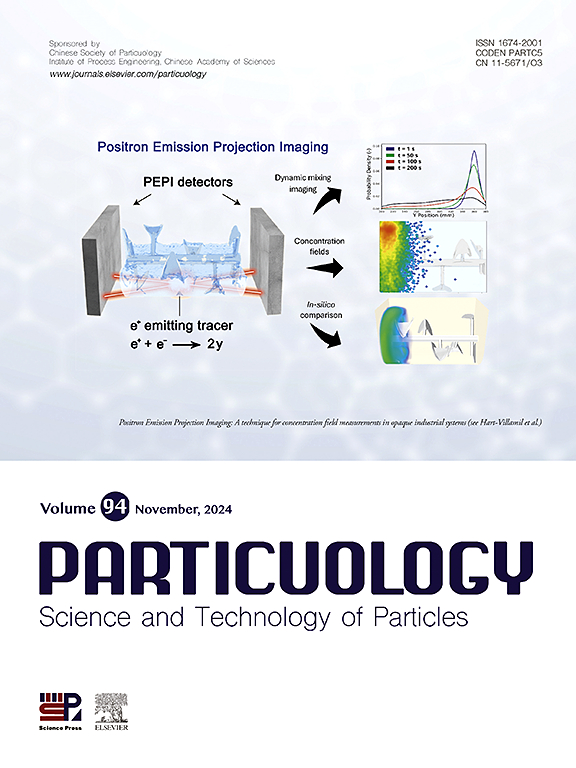气液固循环流动与中尺度参数和测量耦合的数值模拟
IF 4.1
2区 材料科学
Q2 ENGINEERING, CHEMICAL
引用次数: 0
摘要
气液固循环流化床是一种重要的化工反应器类型。通过基于能量最小化多尺度(EMMS)模型的中尺度流动结构参数描述了GLSCFB复杂的中尺度流动结构。提出了液固阻力模型(drag -ls模型),发现由于气相的影响,三相系统的液固阻力系数比液固两相系统的阻力系数增大。基于改进的统一尾流模型,提出了气固阻力模型(drag -gs模型)。将EMMS模型与计算流体动力学(CFD)相结合,更准确地模拟了GLSCFB中颗粒团簇的动态演化过程以及气含率和固含率的分布。仿真结果表明,液相和气相作用于固相的阻力是耦合的,相互影响的。如果单独校正气固两相和液固两相的相互作用,固含率的模拟值可能会偏离实验值。当床层平均固含率较低时,颗粒聚集等中尺度现象不明显。随着固体含率的增加,床层中存在明显的颗粒聚集现象。颗粒经历了高固含率的细长团簇、高固含率的球形团簇和大表面积的低固含率团簇的时空演化过程。本文章由计算机程序翻译,如有差异,请以英文原文为准。

Numerical simulations of gas-liquid-solid circulating flows coupled to mesoscale parameters and measurements
Gas-liquid-solid circulating fluidized bed (GLSCFB) is an important type of chemical reactor. The complex mesoscale flow structure of GLSCFB was described through the mesoscale flow structure parameters based on the energy-minimization multi-scale (EMMS) model. The liquid-solid drag force model (Drag-ls model) was proposed and it was found that the drag coefficient between liquid and solid in three-phase systems increased compared to liquid-solid two-phase systems because of the influence of gas phase. The gas-solid drag force model (Drag-gs model) was proposed based on a modified unified wake model. Furthermore, the combination of EMMS model and computational fluid dynamics (CFD) in GLSCFB was implemented, and the dynamic evolution process of particle clusters and distributions of gas holdup and solid holdup in GLSCFB were simulated more accurately by the models. The simulation results indicate that the drag forces exerted on the solid phase by both the liquid and gas phases are coupled and mutually influence each other. The simulated values of solid holdup may deviate from the experimental values if the interactions between the gas-solid and liquid-solid phases are corrected independently. When the average solid holdup of the bed is low, the mesoscale phenomena such as particle aggregation are not obvious. As the solid holdup increases, there is a significant phenomenon of particle aggregation in the bed. The particles undergo a spatiotemporal evolution process of forming elongated clusters with high solid holdup, spherical clusters with high solid holdup, and clusters with low solid holdup which has large surface areas.
求助全文
通过发布文献求助,成功后即可免费获取论文全文。
去求助
来源期刊

Particuology
工程技术-材料科学:综合
CiteScore
6.70
自引率
2.90%
发文量
1730
审稿时长
32 days
期刊介绍:
The word ‘particuology’ was coined to parallel the discipline for the science and technology of particles.
Particuology is an interdisciplinary journal that publishes frontier research articles and critical reviews on the discovery, formulation and engineering of particulate materials, processes and systems. It especially welcomes contributions utilising advanced theoretical, modelling and measurement methods to enable the discovery and creation of new particulate materials, and the manufacturing of functional particulate-based products, such as sensors.
Papers are handled by Thematic Editors who oversee contributions from specific subject fields. These fields are classified into: Particle Synthesis and Modification; Particle Characterization and Measurement; Granular Systems and Bulk Solids Technology; Fluidization and Particle-Fluid Systems; Aerosols; and Applications of Particle Technology.
Key topics concerning the creation and processing of particulates include:
-Modelling and simulation of particle formation, collective behaviour of particles and systems for particle production over a broad spectrum of length scales
-Mining of experimental data for particle synthesis and surface properties to facilitate the creation of new materials and processes
-Particle design and preparation including controlled response and sensing functionalities in formation, delivery systems and biological systems, etc.
-Experimental and computational methods for visualization and analysis of particulate system.
These topics are broadly relevant to the production of materials, pharmaceuticals and food, and to the conversion of energy resources to fuels and protection of the environment.
 求助内容:
求助内容: 应助结果提醒方式:
应助结果提醒方式:


